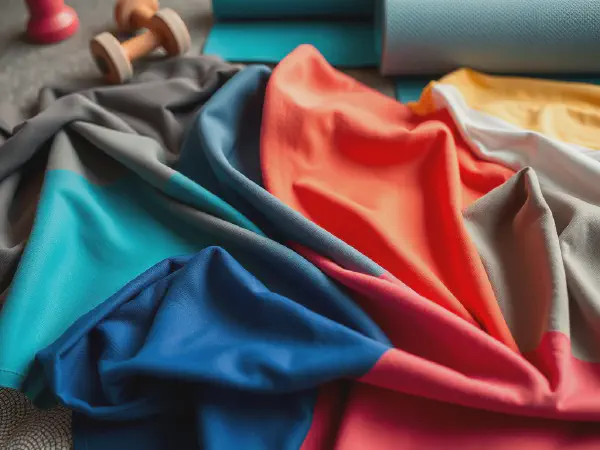Essential Guide to Choosing the Right Workout Apparel Fabric

Workout Apparel Fabric: A Comprehensive Guide to Choosing the Right Materials
Workout apparel fabric plays a crucial role in determining comfort, performance, and durability during physical activities. Whether you're running, cycling, or practicing yoga, the type of fabric you wear can significantly impact your workout experience. Understanding the different types of workout apparel fabrics, their functional properties, and other factors can help you make informed choices that suit your fitness needs.
When selecting workout apparel fabric, it's essential to consider various factors like moisture management, breathability, stretchability, and comfort. The right fabric can enhance your performance, keep you dry and comfortable, and even improve your overall workout experience. This article delves into the types of fabrics available, their functional properties, and other essential aspects of workout apparel that can help you level up your fitness game.
From cotton to synthetic blends, workout apparel fabric comes in various options to cater to different activities and personal preferences. Each fabric type offers distinct advantages and disadvantages, making it crucial to understand your choices. Moreover, with a growing emphasis on sustainability and fashion in activewear, many brands now provide innovative fabric solutions that align with eco-friendly practices and stylish designs.
As the fitness culture continues to evolve, so do the materials used in workout apparel. Manufacturers are constantly researching and developing specialized fabrics that enhance performance, comfort, and style. By learning about these advancements and the importance of choosing the right workout apparel fabric, you can make informed decisions that contribute to a more enjoyable workout experience.
In conclusion, understanding workout apparel fabric is essential for maximizing your performance and comfort during exercise. This comprehensive guide will explore the different fabric types, their functional properties, fit and comfort considerations, sustainability in fabrics, and the intersection of style and aesthetics in workout apparel.
Fabric Types
Workout apparel fabrics can be broadly categorized into natural fibers, synthetic fibers, and blends. Natural fibers like cotton and wool are often praised for their softness and breathability. Cotton, while comfortable, absorbs moisture, which can leave you feeling wet and cold during intense workouts. Wool, on the other hand, offers excellent insulation and moisture-wicking properties but can be bulkier and more expensive. Understanding the pros and cons of these natural fabrics is crucial when selecting your workout gear.
Synthetic fibers like polyester and nylon dominate the performance apparel market due to their moisture-wicking properties, durability, and lightweight feel. Polyester is particularly favored for its quick-drying abilities and resistance to shrinking and stretching. Nylon, known for its strength and elasticity, offers excellent stretch, making it an ideal choice for active movements. However, synthetic fabrics may not be as breathable as natural fibers, which can be a consideration for high-intensity workouts.
Blends, such as cotton-polyester mixes, combine the best of both worlds. These fabrics offer the softness of cotton along with the durability and moisture-wicking properties of synthetic fibers. This means you can enjoy comfort and performance without sacrificing one for the other. Understanding these blends can help you choose clothing that meets both your comfort and workout needs.
Moisture-wicking fabrics are engineered to pull sweat away from the skin and transport it to the fabric's surface, where it can evaporate quickly. This technology is vital for preventing chafing and ensuring you remain comfortable during your workout. Look for labels indicating moisture management technology in workout apparel to ensure you're making the right choice for high-sweat activities.
Breathable fabrics allow air to circulate through the material, keeping you cool and comfortable during workouts. Non-breathable materials can trap heat and moisture, leading to discomfort during exercise. It's essential to read fabric labels and choose workout apparel that emphasizes breathability, especially for high-intensity workouts or warmer climates.
Functional Properties
Moisture management is perhaps the most critical factor in workout apparel. Fabrics that effectively wick moisture away from the body help maintain a stable body temperature and prevent the discomfort associated with damp clothing. Look for materials designed for quick-dry performance to keep you feeling fresh even after the most intense workouts.
Insulation is essential for choosing fabric suitable for different temperatures. In colder climates, you might prefer fabrics that provide warmth without bulk, such as thermal or fleece materials. In contrast, lightweight, breathable fabrics are ideal for warmer weather, helping you stay cool while you exercise. Selecting the right insulation level can make or break your workout experience depending on the season.
Stretchability is vital for workout apparel to allow for freedom of movement during physical activities. Fabrics with added elastic, spandex, or elastane content can provide the flexibility needed for activities such as running, yoga, or weightlifting. Prioritizing stretchable fabrics ensures you can perform various movements without feeling restricted.
Durability is crucial for workout apparel since it endures regular wear and tear. High-quality fabrics resist pilling, fading, and stretching, contributing to the longevity of your gear. When selecting workout apparel, consider the fabric's ability to withstand repeated washing and strenuous activity to ensure it lasts through countless workouts.
Weight can significantly affect performance. Lightweight fabrics are often used in high-intensity workout gear, allowing for unencumbered movement and increased agility. Conversely, things like heavier fabrics may be suitable for low-intensity, colder workouts where added warmth is beneficial. Evaluating your workout intensity can guide you in choosing the right fabric weight.
Fit and Comfort
Understanding fit is essential when selecting workout apparel. Loose-fitting gear allows for breathability and comfort, while tight-fitting options can provide support and enhance performance. The choice between loose vs. tight workout gear depends on personal preference and the type of activity being performed—e.g., yoga may call for looser clothes, while cycling might require a tighter fit.
Size charts play a crucial role in ensuring the right fit for your body. Each brand can have different sizing standards, so it's essential to refer to size charts before making a purchase. A well-fitting garment enhances comfort and performance, while an incorrect fit can lead to discomfort and distraction during your workout.
Seams and stitches are important aspects of construction quality. Flatlock seams help prevent chafing and irritation during movement, while reinforced stitching enhances the durability of the garments. Investing in well-constructed workout apparel ensures a pleasant experience and reduces the risk of damage during workouts.
Chafing can be a significant nuisance during workouts, and choosing fabrics specifically designed to minimize irritation is essential. Some fabrics feature anti-chafing technology or smooth constructions that reduce friction, making them ideal for long-duration workouts or intense activities.
Layering is key for adapting your workout attire to different temperatures and conditions. The best fabrics for multi-layer workouts include moisture-wicking base layers, insulating mid-layers, and protective outer layers. Understanding how to layer your workout gear can ensure you're prepared for any weather while remaining comfortable.
Sustainability in Fabrics
Eco-friendly materials like organic cotton and recycled fabrics are gaining popularity in workout apparel. Organic cotton is free from harmful chemicals and pesticides, making it a healthier option for both the environment and wearers. Recycled fabrics, often derived from plastic bottles or old garments, help reduce waste and promote a circular economy.
Many brands are prioritizing sustainability in their manufacturing processes and product designs. These companies commit to using eco-friendly materials, ethical production practices, and sustainable packaging. Supporting such brands can have a positive impact on the environment and encourage more companies to adopt green initiatives.
Fabric choices can significantly affect the environment due to their production methods and the materials used. Opting for sustainable fabrics can help minimize the carbon footprint associated with apparel manufacturing. Understanding the environmental impacts of different fabric types can guide your purchasing decisions.
The carbon footprint of workout apparel can vary based on the fabric composition and production processes. Consumer demand for sustainable practices has pushed many brands to focus on reducing their carbon emissions and environmental impact. Evaluating a brand's commitment to sustainability can provide insight into the long-term effects of your purchasing choices.
Biodegradable fabrics present a promising future for workout gear, as they break down more naturally in the environment. Innovations in this area aim to reduce waste and promote sustainability in apparel production. Staying informed about advancements in biodegradable fabrics can help you make eco-conscious choices as a consumer.
Style and Aesthetics
Color selection plays a role in both style and functionality. Choosing the right colors for workout apparel can boost motivation and athletic performance, as bright colors often energize, while darker colors can aid in hiding stains and sweat. Personal preferences and style trends also play a significant role in one's workout wardrobe.
Patterns and prints are increasingly popular in workout apparel, allowing individuals to express their personal style. From bold prints to subtle patterns, the trend in workout fashion embraces individuality while providing functional clothing that meets performance needs.
Athleisure is a growing trend that merges fashionable designs with functional workout gear. This style allows individuals to seamlessly transition from workout to everyday activities without compromising comfort or appearance. Recognizing the athleisure trend can help you choose versatile pieces that work in and out of the gym.
Accessorizing can enhance workout aesthetics. Matching fabrics with workout gear through accessories, such as bags, headbands, and shoes, allows individuals to create a cohesive and stylish look. Understanding how to accessorize effectively can elevate your fitness wardrobe while maintaining functionality.
Seasonal styles play a vital role in workout apparel. Adapting clothing to seasonal trends can ensure you stay comfortable during workouts, allowing for temperature control while making fashion statements. Staying aware of seasonal styles can lend fresh new options to your workout wardrobe.
